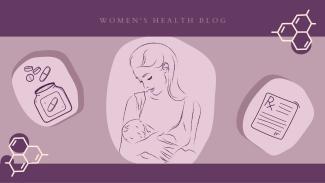Author: Janet C. Currie, MSW, PhD, Research Collaborator at the UBC School of Nursing. Editors: Suzanne Hetzel Campbell PhD, RN, FCNEI, IBCLC, CCSNE, Negin Nia and Arrthy Thayaparan (Blog Coordinators)
Published: March 11th, 2022
Domperidone is a dopamine blocker that is being increasingly prescribed off-label in British Columbia and other provinces to treat low milk supply (LMS). Domperidone increases prolactin, which can stimulate milk production, an unintended side effect.
There is a global consensus on the importance of at least six months of exclusive breastfeeding because of its overwhelming health benefits. An average of 90 per cent of Canadian mothers intend to breastfeed and go on to initiate it. However, by three months the rate of mothers exclusively breastfeeding their newborns has decreased to 51.7 per cent and by six months to 14.4 per cent. One of the most common reasons mothers give for stopping breastfeeding early is because of LMS.
Low milk supply
Physiological factors can contribute to LMS. These include conditions such as mammary hypoplasia, which is limited breast glandular tissue. The prevalence of physical barriers to breastfeeding is thought to be low - from 1 to 15 per cent.
In most cases, LMS appears to be caused by other factors that affect milk supply. These include a mother’s confidence in her milk supply and/or a lack of information about lactation, infant nutritional needs, sleep patterns and hunger cues.
LMS can also be related to the degree a mother receives sustained help with breastfeeding and the medicalization of breastfeeding which can result in a premature diagnosis of LMS and the early introduction of formula.
Increasing use of domperidone in Canada
Two Canadian studies have documented the rise in domperidone use to treat LMS. In BC, between 2002 and 2011, Smolina et al. found that domperidone use increased from 8 to 19 per cent for term births and from 17 to 32 per cent for preterm births. This research showed an increase in the median daily dose from 60 to 80 mg/day and a longer duration of use.
A recent study in BC, Alberta, Saskatchewan, Manitoba and Ontario found domperidone use increased between 2004 and 2017 with some reduction in use after Health Canada’s 2012 domperidone advisor.
Off-label use of domperidone
Health Canada has only approved domperidone to treat digestive problems. When it is prescribed for LMS this is an-off-label, unapproved use. Off-label prescribing occurs when a drug that has been approved for specific use by Health Canada is prescribed for another use for which the drug has not been approved. Off-label prescribing can be beneficial especially when few treatments exist for a condition, but without data derived from the drug approval process it can be difficult to assess a drug’s benefits and harms. In addition, ADRs from off-label uses are not systematically collected or analyzed to identify safety problems.
Domperidone has not been approved for any use in the United States and the distribution or importation of domperidone-containing products into the US violates the law. Domperidone has not been used to treat LMS anywhere in the world.
Safety concerns of domperidone
Domperidone is a QT-prolonging drug which means that it can trigger ventricular arrhythmias. In the most serious cases, this can lead to Torsades de Pointes, an abnormal heart rhythm that can result in cardiac death.
The cardiac risks of domperidone are dose-related. In a 2015 advisory, Health Canada recommended that domperidone be used at a maximum daily dose of 30 mg/day for a short duration. However, Canadian research indicates that domperidone is being prescribed above recommended guidelines, sometimes over 80 mg/day.
Taking other QT-prolonging drugs with domperidone increases cardiac risks. Many common prescription drugs are QT-prolonging. They include fluoroquinolone antibiotics (e.g., Cipro), antidepressants (e.g., escitalopram and citalopram, antifungals (e.g., miconazole), and some antipsychotics.
Using a QT-prolonging drug along with CYP3A4 Inhibitors, a type of enzyme, can trigger risks. Substances with CYP3A4 inhibitors include drugs like erythromycin and foods like grapefruit/ grapefruit juice. Other factors that increase the potential risks of domperidone include having a personal or family history of cardiac problems, liver disease, electrolyte problems, and low blood levels of potassium and magnesium. Female sex is an independent risk factor.
Domperidone is an antipsychotic (neuroleptic). Antipsychotics are psychiatric drugs usually approved to treat conditions like psychoses and schizophrenia. Even if someone is taking domperidone for LMS and not for a mental health condition, the potential for adverse drug reactions (ADRs) can be the same. ADRs may intensify if the drug is reduced or stopped rapidly, especially from high doses.
Recent case studies and reports to the Infant Risk Information Centre at Texas Technical University indicate that some people using domperidone for LMS are experiencing serious adverse reactions when they stop. ADRs effects from stopping domperidone could include fatigue, movement/muscle problems, weight gain, anxiety, agitation, palpitations, dry mouth/eyes, dizziness/ poor balance, gastrointestinal problems, insomnia, cognition problems, listlessness and depression and, in serious cases, psychoses or suicidal feelings.
To reduce antipsychotic withdrawal symptoms, domperidone should be tapered consistently and slowly in small increments with a period of 2-4 weeks between reductions or at a pace that is tolerable. A tapering plan should be discussed with a healthcare provider knowledgeable about antipsychotic withdrawal.
The safety of domperidone absorbed by babies through breastmilk has not yet been clearly established.
Effectiveness of domperidone
Evidence of domperidone’s effectiveness from randomized control trials is of low quality with small study enrollment, short-term tracking, (1-2 weeks), a focus on low doses, a lack of meaningful outcome measures such as duration of breastfeeding and limited reporting of ADRs. In most cases, where domperidone resulted in an increase in milk volume, the increase was not significant. Higher dose levels were not associated with significant increases in milk volume.
